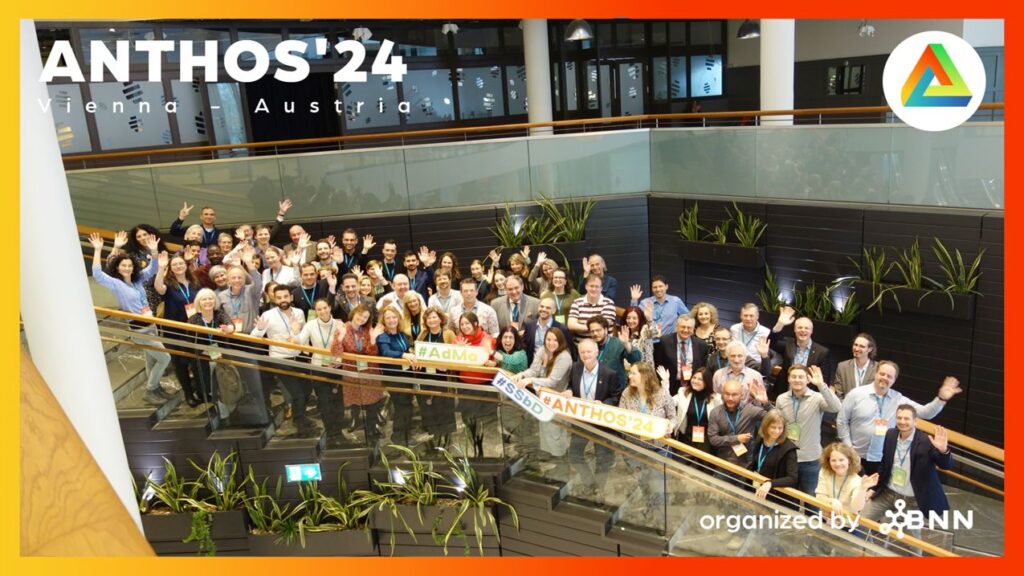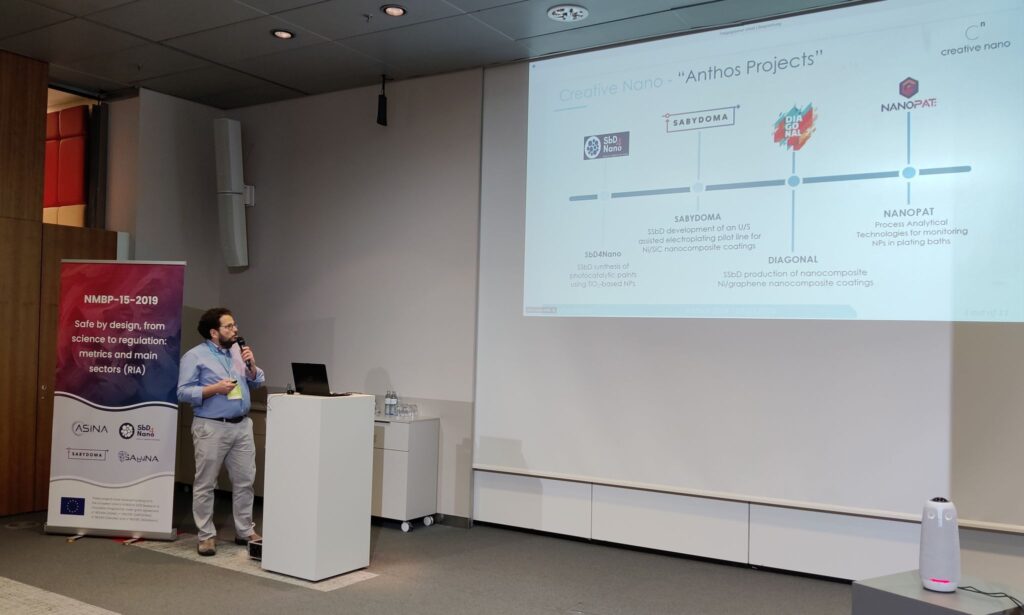The first summit of its kind, ANTHOS’24 – “Advanced (Nano)Materials and Technologies: science, research & innovation for safety and sustainability” – took place from 4 to 7 March 2024 at the TWELVE Conference Center in Vienna and was accompanied by satellite events before and after the core program.
ANTHOS’24 was initiated, conceptualised and organised by BNN to promote advancements in technological innovation & research results on Safe-by-Design (SbD) for advanced (nano-) materials and beyond.
The event served as a platform for bringing together leading experts in SbD and Safe-and-Sustainable-by-Design (SSbD), including partners active in projects funded under the frame of H2020 and Horizon Europe. Notably, representatives of key organisations and international stakeholder groups (European Commission, OECD, EFSA, ECHA, National Ministries, Industry), as well as relevant associations and initiatives actively contributed to the event.
ANTHOS’24 provided the ideal stage to disseminate results obtained in projects addressing “Safe by design, from science to regulation: metrics and main sectors” (NMBP-15) and “Safe by design, from science to regulation: multi-component nanomaterials” (NMBP-16), and dive deeper and discuss overarching topics of SbD and SSbD. These projects are at the forefront of developing tools and methods that embody the concept of SSbD. This innovative approach ensures that safety and sustainability considerations are woven into the early phases of nanomaterial innovation. By doing so, these projects shall prevent late development failures and also pave the way for a seamless transition to the market.
BNN initiated and organized ANTHOS’24, supported by the EU NanoSafety Cluster, and the sister projects’ collaboration of the NMBP-15 projects ASINA, SAbyNA, SABYDOMA, SbD4Nano and NMBP-16 projects DIAGONAL, HARMLESS, SUNSHINE, as well as IRISS and PARC.
BioNanoNet General Assembly & BNN Networking Event
On Monday, 4 March, the BioNanoNet Association’s General Assembly brought together its members to discuss the latest developments of the Association, followed by the BNN Networking Event which kicked off the open event to all participants. The networking started with short presentations of the recently launched Horizon Europe projects SSbD4Chem, PINK, CHIASMA and INSIGHT, in which BioNanoNet members play key roles. Afterwards, the Austrian Research Promotion Agency presented the open EUREKA call. Finally, BNN gave an overview on its expertise (which are assets for any R&D&I project) in SSbD-implementation and how BNN can support other organisations’ ideas to reach the market with BNN Innovation Support, including BNN competences in regulatory advice. The closing of the day was marked by delicious traditional Austrian food in the Luftburg, Austria’s largest fully certified organic restaurant situated in Vienna’s well-known leisure park Prater.
NMBP-15 Final Event
The second day of ANTHOS’24, Tuesday, 5 March, revolved around “Science-driven methods and tools for the transformation of Safe-by-Design”. In a series of talks structured around SbD of processes and materials – ranging from nanomaterials to advanced materials – legal aspects were also addressed and critically discussed. A highlight of Tuesday were the presentations of successful case studies of SbD in action from the NMBP-15 projects (ASINA, SABYDOMA, SAbyNA, SbD4Nano) by companies (Applied Nanoparticles, Creative Nano, AVANZARE, UNI).
In the last session Andreas Falk, CEO of BNN and member of the coordination team of the EU NanoSafety Cluster (NSC), moderated a roundtable discussion on “Lessons learned & future impact of the developed methods and tools” hosting experts from the NMBP-15 projects, the OECD WPMN, the German Ministry of Environment, and the European Commission Joint Research Centre. They discussed and elaborated on different views, advantages and pitfalls of the newly developed tools and methods. In their discussion it became clear that from the legal perspective there is not yet a solid trust and regulatory acceptance of New Approach Methodologies (NAMs), such as developed in the presented projects, and that there still is a call for further developing actual test guidelines to make them applicable for advanced (nano)-materials. Additionally, concerns about the possibilities and dangers of read-across over different materials was a central topic. While the scientific side agreed to the need to properly validate NAMs and be cautious when it comes to read-across, the potential plurality of such approaches was discussed in the context of using different approaches to advance the same idea. Importantly, it was acknowledged that a major necessity is to provide high-quality data, ideally stemming from robust methods to the developed models to allow them to predict outcomes reliably. Ultimately, reliable models are needed to further advance in their TRLs and ensure their acceptance not only among the community, but also society and regulators. Harmonisation of tools and methodological approaches will pave the way for this, while efficient and accessible data storage and constant dissemination of scientific outcomes are key goals.
All in all, it was agreed that the collaborative nature of these projects will be the key to advancing the idea of a safer and more sustainable future and successfully translate it to industry, providing an incentive for it to be implemented. This can be achieved by successful knowledge transfer and training among the people involved within the topic, and also bringing the knowledge to higher hierarchical levels and taking company leaders into the discourse and holding them accountable. The fantastic day culminated in the rooftop event location ThirtyFive with a breathtaking view of the city’s lights, delicious food from live cooking stations, lively conversations and great live music, which even sparked some dancing!
NMBP-16, PARC & IRISS Sessions
The second half of ANTHOS’24 was marked by elaborations on projects (SUNSHINE, DIAGONAL, HARMLESS, PARC, IRISS) on SSbD in full action focusing on “Translation and implementation of SSbD: Towards an innovation-driven ecosystem” on Wednesday, 6 March. Like the previous day, participants got to enjoy exciting talks, focusing more on SSbD, its translation and valorization and application to multicomponent nanomaterials. Additionally, decision support systems, industrial implementation of SSbD and knowledge sharing within the community were hot topics of the day.
The final session of the day was a roundtable discussion, moderated by Monique Groenewold from RIVM and member of the NSC coordination team, on “Creating long-term impact for society considering multistakeholder needs”. The discussion was launched with a topic already discussed at the previous roundtable: the incentive for industry to implement SSbD and ways to improve regulators’ trust in novel tools. Approaches mentioned included simple-to-use tools, as well as the implementation of consultancy services to make SSbD more feasible. Especially SMEs are often lacking the expertise and resources to investigate and combine safety and sustainability, while they are the backbone of innovation in the European field. The roundtable participants therefore discussed the need for “simplexity” of SSbD and related tools, as simple as possible, while remaining as complex as needed, which can be achieved by transparency and harmonisation. While the use of tools was also heavily discussed at the roundtable, it was made clear that it is still experts working on innovation and its governance. On the other hand, it was brought up that tools can be sophisticated and should not be oversimplified, but accessible for the end user. An important task in the years to come will be to shape the future experts and challenge students early on in their careers during their master’s and PhD programs to ensure their understanding of not only tools and approaches within a narrow field, but allow for translational and trans-sectional discourse, which will ultimately provide an entirely new generation of experts. An analogy with which the roundtable was closed was that SSbD is like a forest and the available and developed tools are the trees within the forest.
Finally, the main event concluded with closing statements of the conference chair Andreas Falk, depicting highlights of ANTHOS’24 before the participants got to enjoy a final dinner together!
SABYDOMA and DIAGONAL: satellite events
ANTHOS’24 ended with the Workshop “A stakeholder’s perspective of Safe-and-Sustainable-by-Design – a bigger picture!” organised by SABYDOMA, the SABYDOMA Technology Showcase, and an Expert Workshop on “Public Perceptions of Nanoparticles in Cosmetics: Challenges and Opportunities” organised by DIAGONAL.
In the morning of 7 March, SABYDOMA organised a follow-up SSbD workshop to the previously held in February 2022, to explore what progress has been made on SSbD since then. The workshop, entitled “A stakeholder’s perspective of Safe-and-Sustainable-by-Design – a bigger picture!”, highlighted the past four years of research and dissemination on the SSbD approach, with the contribution of stakeholders from academia (UoB), European Commission, policy makers (Cefic, ChemSec), industry (APPNPS, NIA, TEMASOL) and relevant ongoing projects (PARC), who discussed the current status and understanding of the SSbD approach. The workshop started with a presentation on SABYDOMA’s legal paper covering the content and findings of the two legal workshops organised in January 2021 and June 2023, and was followed by a roundtable discussion with panellists answering questions on the implementation, challenges and potential developments of the SSbD approach since the European Commission recommendation was published on 8 December 2022 and in light of the ongoing scientific research. Further information on the workshop can be found on the SABYDOMA webpage.
After that, SABYDOMA organised a Technology Showcase where the four years of research performed in the SABYDOMA project were highlighted. Participants were able to observe a demonstrator showing the coupling of a nanoparticle production line with a cell line screening platform, which were both developed during the SABYDOMA project. This demonstrator simulated the production of nanoparticles in a compact microfluidic set-up and their transfer to a screening module with integrated optical and electrical sensing. The module can be used to investigate the toxicological effect of the nanoparticles on living biological cells. Further information on the Technology Showcase can be found on the SABYDOMA webpage.
In parallel with the SABYDOMA Technology Showcase, the DIAGONAL project organised an interactive Expert Workshop on Public Perceptions of Nanoparticles in Sunscreens: Challenges and Opportunities. Further information on the workshop can be found on the DIAGONAL webpage.
All in one, ANTHOS’24 was a real success, presenting cutting-edge research and advances in the field of Safe-and-Sustainable-by-Design and advanced materials, and also brought together a lively crowd of highly motivated experts who are already eagerly planning their next steps, potentially with some newly found collaboration partners!
ANTHOS’24 overall program is available here, as well as a daily agenda here.
The Book of Abstracts, with all presentations of ANTHOS’24 speakers, can be found here.
A selection of ANTHOS’24 photos is available here.
RECORDINGS:
Recording Day 1 (5.3.2024) – Part 1: WATCH RECORDING
Recording Day 1 (5.3.2024) – Part 2: WATCH RECORDING
Recording Day 2 (6.3.2024): WATCH RECORDING
Colleagues from Cnano, TEMASOL and BNN participated in ANTHOS’24. In addition to the overall networking activity, Alex Grigoropoulos (Cnano) gave an oral presentation on 5 March on “Promoting photocatalytic activity of S-doped TiO2 NPs by applying a SbD modification”, promoting mainly the research carried out in the SbD4Nano project, but highlighting the collaboration between projects, the impact of EU funded projects, as well as the role of NanoPAT in their developments.
Some highlights of ANTHOS’24:



